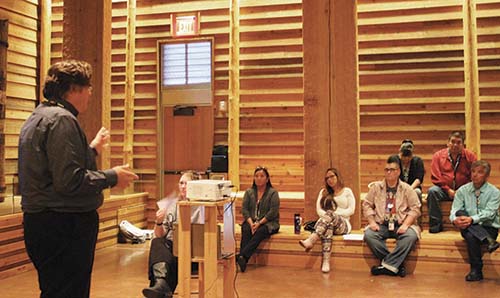
By Kalvin Valdillez, Tulalip News
The heroin and opioid epidemic has hit America hard in recent years. According to a study conducted by the University of Washington Alcohol and Drug Abuse Institute, thirty-one percent of deaths statewide can be credited to drug overdose. The epidemic has unfortunately claimed the lives of many loved ones nationwide. Previously, addicts who wanted to become clean would often fail because they were not provided with the proper resources and tools while attempting to become sober. In many cases, addicts are eventually caught with possession of drugs, and sometimes turn to thievery for the intent of supplying their high, and are reported to the authorities. The traditional court is a flawed system when it comes to dealing with individuals who committed a non-violent crime fueled by their addiction. For this reason, drug courts were invented. Drug courts can be found nationwide and are utilized by individuals who are battling addiction and were convicted on drug-related charges.
The state of Washington sees approximately three thousand deaths annually due to drug abuse, according to the Washington State Department of Health. In Snohomish County there are around six to seven hundred drug related casualties per year, with the largest amount of overdoses occurring in Everett, Marysville and Tulalip. Tulalip has made an enormous effort to help heal their people in the form of the Healing to Wellness Court. There are many similarities between drug court and Tulalip’s Wellness Court, such as random drug tests, required court appearances, and numerous resources. Tulalip has modified the drug court model to fit the needs of addicted tribal members, ensuring that there’s an emphasis on culture and community with the new Wellness Court.
“The difference from drug court is mostly the integration of the cultural programs and the community the program is in. In Wellness Court we ask our participants to be in the community,” states Wellness Court judge, Ron Whitener. “A lot of the participants have to rebuild their relationships with the community because a lot of them have burned some bridges on their way into Wellness Court. It is something positive they can work on while they are also working on their treatment and education. We want to help reintegrate them back into this community.”
Wellness Court is held once a week on Tuesdays, and participants are required to stay for the entire duration of court. The court sessions, typically an hour long, display a new twist to the traditional courtroom scene. Participants approach the podium to speak to Judge Whitener directly about their struggles and successes each week. Wellness Court uses a system of sanctions and incentives to help keep their clients on track. Sanctions include increased court appearances, community service hours and writing assignments. While incentives include gift cards, movie passes, decreased court appearances and later curfews.
“Our goal is to heal the individual completely, not just the addiction,“ states Wellness Court Coordinator Hilary Sotomish. The Wellness Court team works as a cohesive unit, meeting weekly to review each participant’s progress, ensuring that everybody is on the same page as communication is key amongst the Wellness Court team. The team is comprised of members from several departments including Behavioral Health and Recovery, the Healing Lodge, Housing Hope, Tulalip Housing, the Karen I. Fryberg Health Clinic, University of Washington Tribal Public Defense Clinic, and the Tulalip Police Department.
The Tulalip Police Department assigned three officers to the Wellness Court team. The officers take on a new role, at least from the participant’s perspective, as they interact in a positive, supportive manner while encouraging participants during their road to recovery. Current participants are happy to see the officers in the community and often converse with the officers about their weekly progress.
Tulalip Police Chief Carlos Echevarria states, “Wellness Court allows my law enforcement officers to have greater interactions with the participants. Often the officers will stop by and say hello and ask them how they are doing. We ensure we are providing positive feedback and often the officers will take the time to listen to what the participants have to say. They are building great relationships with each other.”
The five-stage program has no fee with the exception of a fifty-dollar GPS ankle device, which is used to monitor the location of the participant as well to ensure that curfews are met. Cultural activities such as sweat lodge, red road to sobriety and other local events are encouraged.
“Our goal is to keep people involved and to work to help them. As long as the individual is showing they are committed to working and trying, we are going to keep working and trying,” states Hilary.
Tulalip tribal member Robin Hood approached the judge on his twenty-fifth day sober -an accomplishment met with tremendous applaud from the judge and the courtroom, to talk about his past week. Robin is currently staying at the Healing Lodge and attended two more than the required group therapy sessions. However, he missed one of his daily call-ins and received a write-up from the Healing Lodge, which resulted in sanctions of two hours of community service and a one-page written essay on why he missed his daily call in.
“Wellness court can be an easy process, you just got to show up every day and do what is required. It’s only hard if you make it hard, that’s my motto. My experience is going fine. I’m doing this because I know that other people will follow so I’m trying to be a leader. I think this is a positive thing for myself and for my community, and it’s working,” Hood states. “Like my dad always says, ‘it works, if you work it’. Another quote I like is, ‘chase your sobriety like you chase the dope man.’ That’s exactly how sobriety works; you got to want it. If you ain’t wanting it, you ain’t getting it. I’m really glad I’m here. The wellness team has been there to support me one hundred percent. If it wasn’t for them I wouldn’t be clean and sober.”
For more information about the Healing to Wellness Court please contact (360) 716-4773.




